check engine light DACIA DUSTER 2010 1.G Owners Manual
[x] Cancel search | Manufacturer: DACIA, Model Year: 2010, Model line: DUSTER, Model: DACIA DUSTER 2010 1.GPages: 200, PDF Size: 7.12 MB
Page 19 of 200
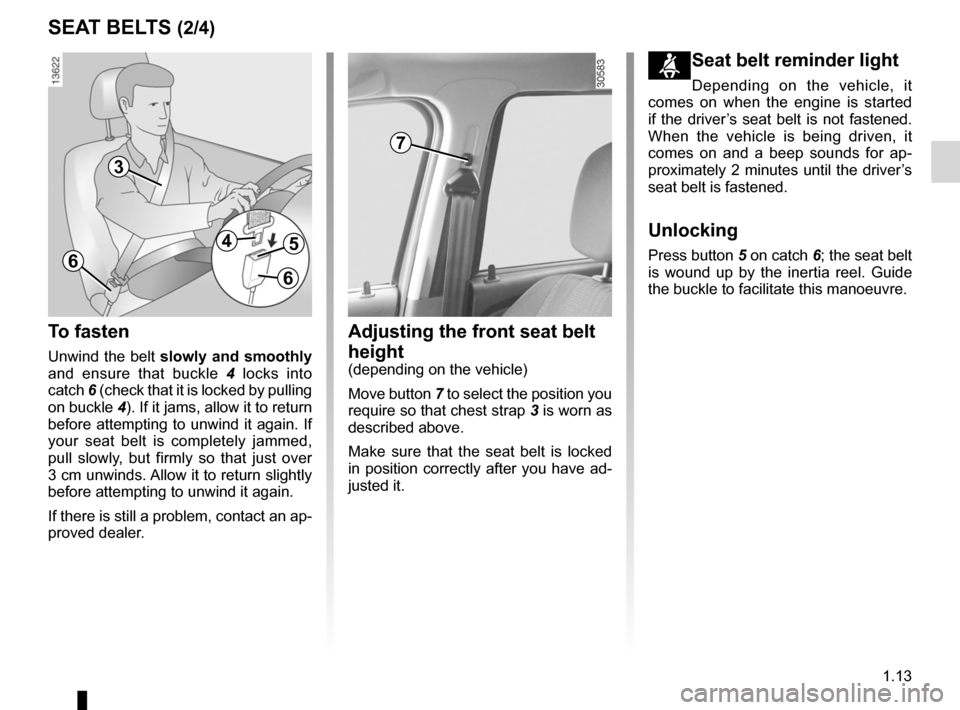
JauneNoirNoir texte
1.13
ENG_UD22430_3
Ceintures de sécurité (H79 - Dacia)
ENG_NU_898-5_H79_Dacia_1
SEAT BELTS (2/4)
To fasten
Unwind the belt slowly and smoothly
and ensure that buckle 4 locks into
catch 6 (check that it is locked by pulling
on buckle 4). If it jams, allow it to return
before attempting to unwind it again. If
your seat belt is completely jammed,
pull slowly, but firmly so that just over
3 cm unwinds. Allow it to return slightly
before attempting to unwind it again.
If there is still a problem, contact an ap-
proved dealer.
Adjusting the front seat belt
height
(depending on the vehicle)
Move button 7 to select the position you
require so that chest strap 3 is worn as
described above.
Make sure that the seat belt is locked
in position correctly after you have ad-
justed it.
ßSeat belt reminder light
Depending on the vehicle, it
comes on when the engine is started
if the driver’s seat belt is not fastened.
When the vehicle is being driven, it
comes on and a beep sounds for ap -
proximately 2 minutes until the driver’s
seat belt is fastened.
Unlocking
Press button 5 on catch 6; the seat belt
is wound up by the inertia reel. Guide
the buckle to facilitate this manoeuvre.
3
45
6
6
7
Page 26 of 200
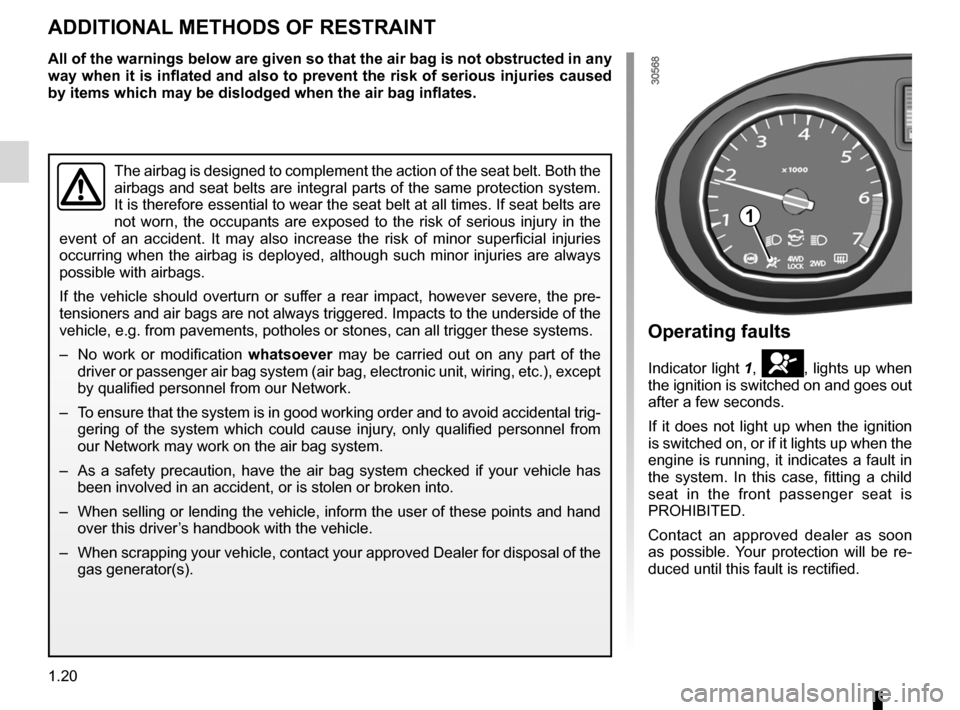
air bag.................................................................... (current page)
seat belts ............................................................... (current page)
methods of restraint in addition to the front seat belts
(current page)
1.20
ENG_UD17556_1
Dispositifs de retenue complémentaires (H79 - Dacia)
ENG_NU_898-5_H79_Dacia_1
Additional methods of restraint
The airbag is designed to complement the action of the seat belt. Both the
airbags and seat belts are integral parts of the same protection system.
It is therefore essential to wear the seat belt at all times. If seat belts are
not worn, the occupants are exposed to the risk of serious injury in the
event of an accident. It may also increase the risk of minor superficial injuries
occurring when the airbag is deployed, although such minor injuries are always
possible with airbags.
If the vehicle should overturn or suffer a rear impact, however severe, the pre-
tensioners and air bags are not always triggered. Impacts to the underside of the
vehicle, e.g. from pavements, potholes or stones, can all trigger these \
systems.
– No work or modification whatsoever may be carried out on any part of the
driver or passenger air bag system (air bag, electronic unit, wiring, etc.), except
by qualified personnel from our Network.
– To ensure that the system is in good working order and to avoid accidental trig-
gering of the system which could cause injury, only qualified personnel from
our Network may work on the air bag system.
– As a safety precaution, have the air bag system checked if your vehicle has
been involved in an accident, or is stolen or broken into.
– When selling or lending the vehicle, inform the user of these points and hand
over this driver’s handbook with the vehicle.
– When scrapping your vehicle, contact your approved Dealer for disposal of the
gas generator(s).
All of the warnings below are given so that the air bag is not obstructed in any
way when it is inflated and also to prevent the risk of serious injuries caused
by items which may be dislodged when the air bag inflates.
ADDITIONAL METHODS OF RESTRAINT
Operating faults
Indicator light 1, å, lights up when
the ignition is switched on and goes out
after a few seconds.
If it does not light up when the ignition
is switched on, or if it lights up when the
engine is running, it indicates a fault in
the system. In this case, fitting a child
seat in the front passenger seat is
PROHIBITED.
Contact an approved dealer as soon
as possible. Your protection will be re-
duced until this fault is rectified.
1
Page 47 of 200
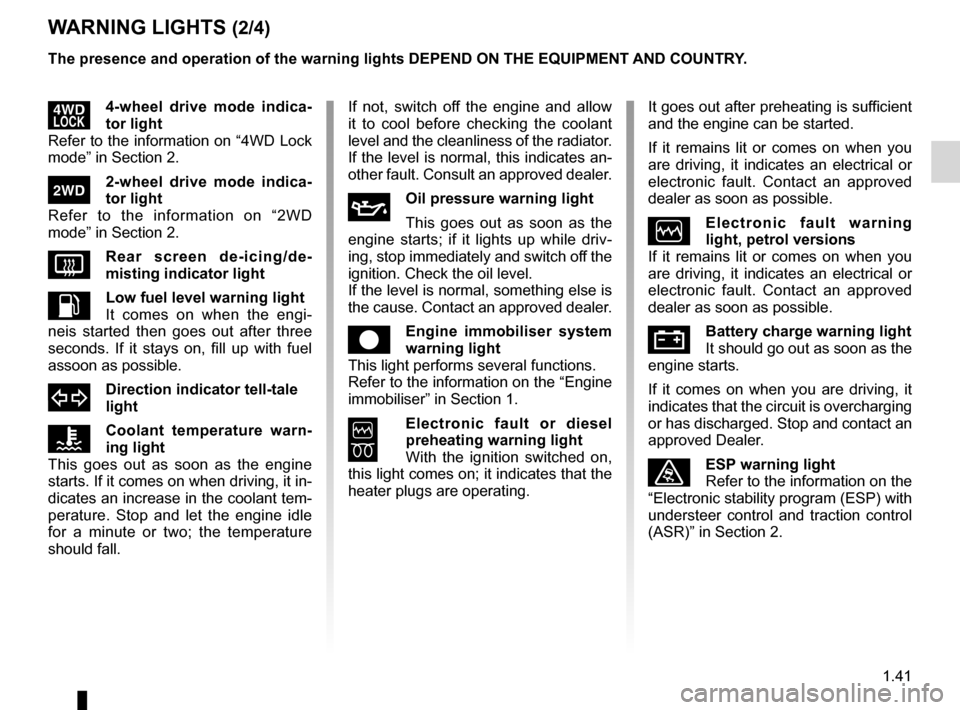
JauneNoirNoir texte
1.41
ENG_UD24501_4
Témoins lumineux (H79 - Dacia)
ENG_NU_898-5_H79_Dacia_1
WARNING LIGHTS (2/4)
If not, switch off the engine and allow
it to cool before checking the coolant
level and the cleanliness of the radiator.
If the level is normal, this indicates an-
other fault. Consult an approved dealer.
ÀOil pressure warning light
This goes out as soon as the
engine starts; if it lights up while driv -
ing, stop immediately and switch off the
ignition. Check the oil level.
If the level is normal, something else is
the cause. Contact an approved dealer.
êEngine immobiliser system
warning light
This light performs several functions.
Refer to the information on the “Engine
immobiliser” in Section 1.
6
Electronic fault or diesel
preheating warning light
With the ignition switched on,
this light comes on; it indicates that the
heater plugs are operating.
It goes out after preheating is sufficient
and the engine can be started.
If it remains lit or comes on when you
are driving, it indicates an electrical or
electronic fault. Contact an approved
dealer as soon as possible.
ÒElectronic fault warning
light, petrol versions
If it remains lit or comes on when you
are driving, it indicates an electrical or
electronic fault. Contact an approved
dealer as soon as possible.
ÚBattery charge warning light
It should go out as soon as the
engine starts.
If it comes on when you are driving, it
indicates that the circuit is overcharging
or has discharged. Stop and contact an
approved Dealer.
ùESP warning light
Refer to the information on the
“Electronic stability program (ESP) with
understeer control and traction control
(ASR)” in Section 2.
The presence and operation of the warning lights DEPEND ON THE EQUIPMENT\
AND COUNTRY.
’4-wheel drive mode indica
-
tor light
Refer to the information on “4WD Lock
mode” in Section 2.
‘2-wheel drive mode indica -
tor light
Refer to the information on “2WD
mode” in Section 2.
VRear screen de-icing/de -
misting indicator light
LLow fuel level warning light
It comes on when the engi -
neis started then goes out after three
seconds. If it stays on, fill up with fuel
assoon as possible.
dDirection indicator tell-tale
light
ÔCoolant temperature warn -
ing light
This goes out as soon as the engine
starts. If it comes on when driving, it in-
dicates an increase in the coolant tem-
perature. Stop and let the engine idle
for a minute or two; the temperature
should fall.
Page 48 of 200
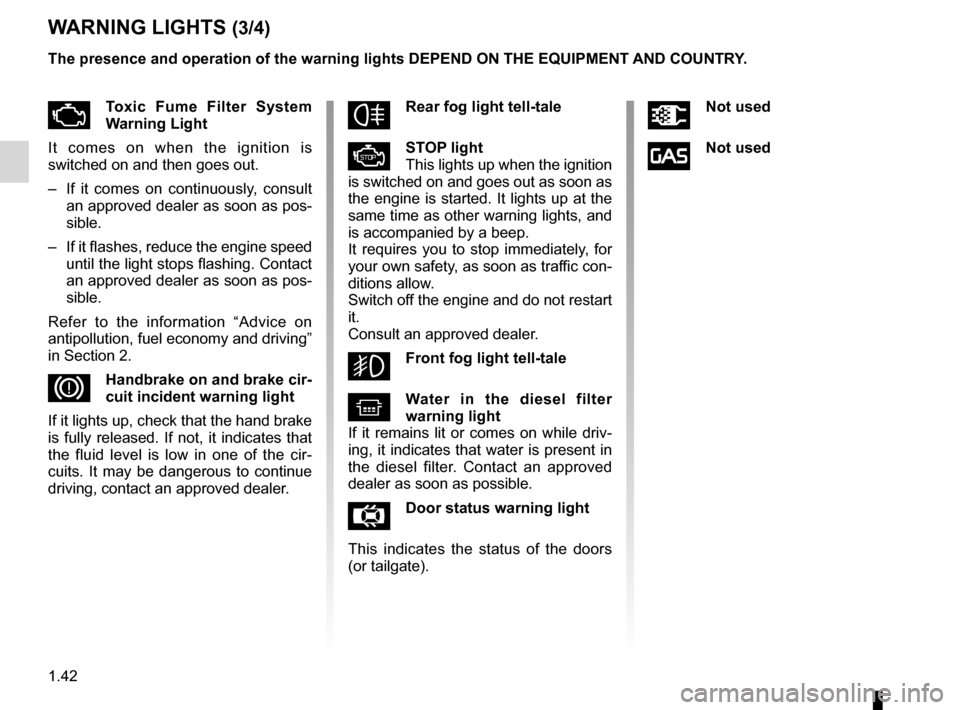
rear screendemisting ......................................................... (current page)
1.42
ENG_UD24501_4
Témoins lumineux (H79 - Dacia)
ENG_NU_898-5_H79_Dacia_1
Jaune NoirNoir texte
WARNING LIGHTS (3/4)
The presence and operation of the warning lights DEPEND ON THE EQUIPMENT\
AND COUNTRY.
ÄToxic Fume Filter System
Warning Light
It comes on when the ignition is
switched on and then goes out.
– If it comes on continuously, consult
an approved dealer as soon as pos-
sible.
– If it flashes, reduce the engine speed
until the light stops flashing. Contact
an approved dealer as soon as pos-
sible.
Refer to the information “Advice on
antipollution, fuel economy and driving”
in Section 2.
DHandbrake on and brake cir-
cuit incident warning light
If it lights up, check that the hand brake
is fully released. If not, it indicates that
the fluid level is low in one of the cir -
cuits. It may be dangerous to continue
driving, contact an approved dealer.
fRear fog light tell-tale
ÆSTOP light
This lights up when the ignition
is switched on and goes out as soon as
the engine is started. It lights up at the
same time as other warning lights, and
is accompanied by a beep.
It requires you to stop immediately, for
your own safety, as soon as traffic con-
ditions allow.
Switch off the engine and do not restart
it.
Consult an approved dealer.
gFront fog light tell-tale
^Water in the diesel filter
warning light
If it remains lit or comes on while driv-
ing, it indicates that water is present in
the diesel filter. Contact an approved
dealer as soon as possible.
ÅDoor status warning light
This indicates the status of the doors
(or tailgate).
ÜNot used
îNot used
Page 74 of 200
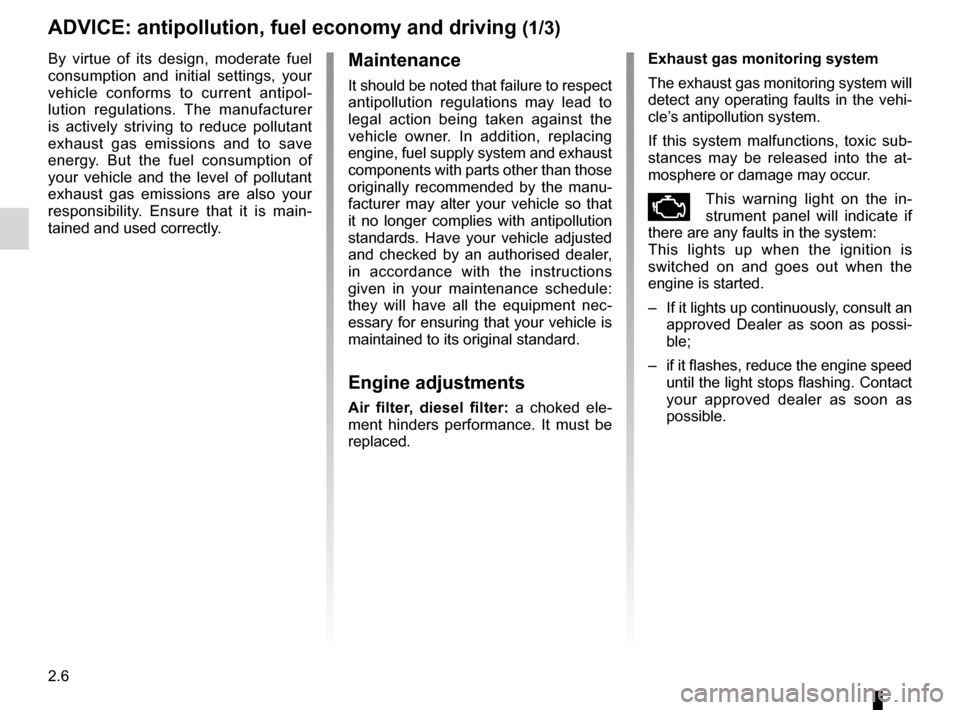
antipollutionadvice ............................................. (up to the end of the DU)
fuel advice on fuel economy .................. (up to the end of the DU)
driving ................................................... (up to the end of the DU)
fuel economy ........................................ (up to the end of the DU)
2.6
ENG_UD22435_3
Conseils : antipollution, économies de carburant, conduite (H79 - Da\
cia)
ENG_NU_898-5_H79_Dacia_2
Jaune NoirNoir texte
Advice: antipollution, fuel economy and driving
By virtue of its design, moderate fuel
consumption and initial settings, your
vehicle conforms to current antipol -
lution regulations. The manufacturer
is actively striving to reduce pollutant
exhaust gas emissions and to save
energy. But the fuel consumption of
your vehicle and the level of pollutant
exhaust gas emissions are also your
responsibility. Ensure that it is main -
tained and used correctly.Maintenance
It should be noted that failure to respect
antipollution regulations may lead to
legal action being taken against the
vehicle owner. In addition, replacing
engine, fuel supply system and exhaust
components with parts other than those
originally recommended by the manu -
facturer may alter your vehicle so that
it no longer complies with antipollution
standards. Have your vehicle adjusted
and checked by an authorised dealer,
in accordance with the instructions
given in your maintenance schedule:
they will have all the equipment nec -
essary for ensuring that your vehicle is
maintained to its original standard.
Engine adjustments
Air filter, diesel filter: a choked ele-
ment hinders performance. It must be
replaced. Exhaust gas monitoring system
The exhaust gas monitoring system will
detect any operating faults in the vehi-
cle’s antipollution system.
If this system malfunctions, toxic sub
-
stances may be released into the at -
mosphere or damage may occur.
ÄThis warning light on the in -
strument panel will indicate if
there are any faults in the system:
This lights up when the ignition is
switched on and goes out when the
engine is started.
– If it lights up continuously, consult an
approved Dealer as soon as possi -
ble;
– if it flashes, reduce the engine speed
until the light stops flashing. Contact
your approved dealer as soon as
possible.
ADVICE: antipollution, fuel economy and driving (1/3)
Page 75 of 200
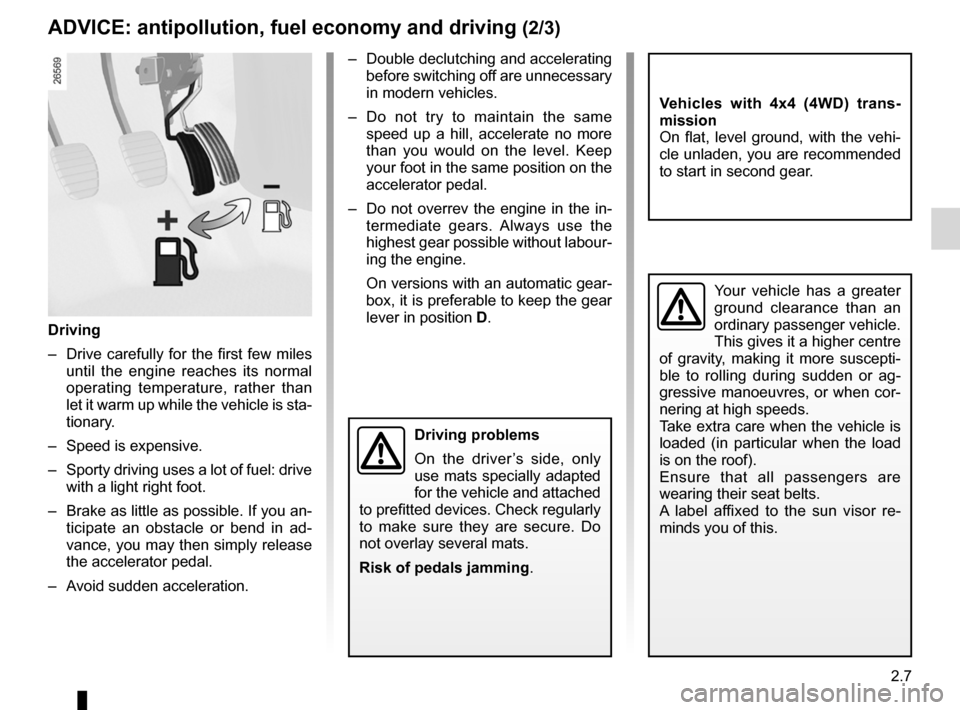
JauneNoirNoir texte
2.7
ENG_UD22435_3
Conseils : antipollution, économies de carburant, conduite (H79 - Da\
cia)
ENG_NU_898-5_H79_Dacia_2
Driving
– Drive carefully for the first few miles
until the engine reaches its normal
operating temperature, rather than
let it warm up while the vehicle is sta-
tionary.
– Speed is expensive.
– Sporty driving uses a lot of fuel: drive
with a light right foot.
– Brake as little as possible. If you an-
ticipate an obstacle or bend in ad -
vance, you may then simply release
the accelerator pedal.
– Avoid sudden acceleration.
ADVICE: antipollution, fuel economy and driving (2/3)
– Double declutching and accelerating
before switching off are unnecessary
in modern vehicles.
– Do not try to maintain the same
speed up a hill, accelerate no more
than you would on the level. Keep
your foot in the same position on the
accelerator pedal.
– Do not overrev the engine in the in-
termediate gears. Always use the
highest gear possible without labour-
ing the engine.
On versions with an automatic gear-
box, it is preferable to keep the gear
lever in position D.
Your vehicle has a greater
ground clearance than an
ordinary passenger vehicle.
This gives it a higher centre
of gravity, making it more suscepti-
ble to rolling during sudden or ag -
gressive manoeuvres, or when cor-
nering at high speeds.
Take extra care when the vehicle is
loaded (in particular when the load
is on the roof).
Ensure that all passengers are
wearing their seat belts.
A label affixed to the sun visor re -
minds you of this.
Vehicles with 4x4 (4WD) trans -
mission
On flat, level ground, with the vehi-
cle unladen, you are recommended
to start in second gear.
Driving problems
On the driver ’s side, only
use mats specially adapted
for the vehicle and attached
to prefitted devices. Check regularly
to make sure they are secure. Do
not overlay several mats.
Risk of pedals jamming .
Page 97 of 200
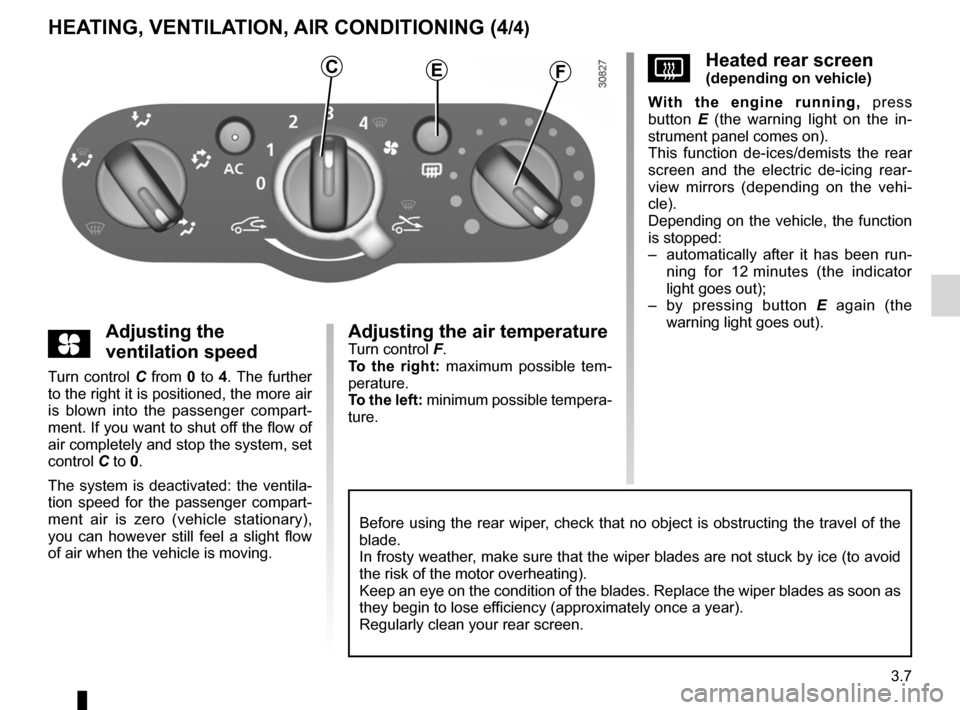
JauneNoirNoir texte
3.7
ENG_UD25124_1
Chauffage - Ventilation - Air conditionné (H79 - Dacia)
ENG_NU_898-5_H79_Dacia_3
HEATING, VENTILATION, AIR CONDITIONING (4/4)
yAdjusting the
ventilation speed
Turn control C from 0 to 4. The further
to the right it is positioned, the more air
is blown into the passenger compart -
ment. If you want to shut off the flow of
air completely and stop the system, set
control C to 0.
The system is deactivated: the ventila -
tion speed for the passenger compart-
ment air is zero (vehicle stationary),
you can however still feel a slight flow
of air when the vehicle is moving.
Adjusting the air temperatureTurn control F.
To the right: maximum possible tem -
perature.
To the left: minimum possible tempera-
ture.
VHeated rear screen(depending on vehicle)
With the engine running, press
button E (the warning light on the in -
strument panel comes on).
This function de-ices/demists the rear
screen and the electric de-icing rear -
view mirrors (depending on the vehi -
cle).
Depending on the vehicle, the function
is stopped:
– automatically after it has been run -
ning for 12 minutes (the indicator
light goes out);
– by pressing button E again (the
warning light goes out).CEF
Before using the rear wiper, check that no object is obstructing the travel of the
blade.
In frosty weather, make sure that the wiper blades are not stuck by ice (to avoid
the risk of the motor overheating).
Keep an eye on the condition of the blades. Replace the wiper blades as soon as
they begin to lose efficiency (approximately once a year).
Regularly clean your rear screen.
Page 116 of 200
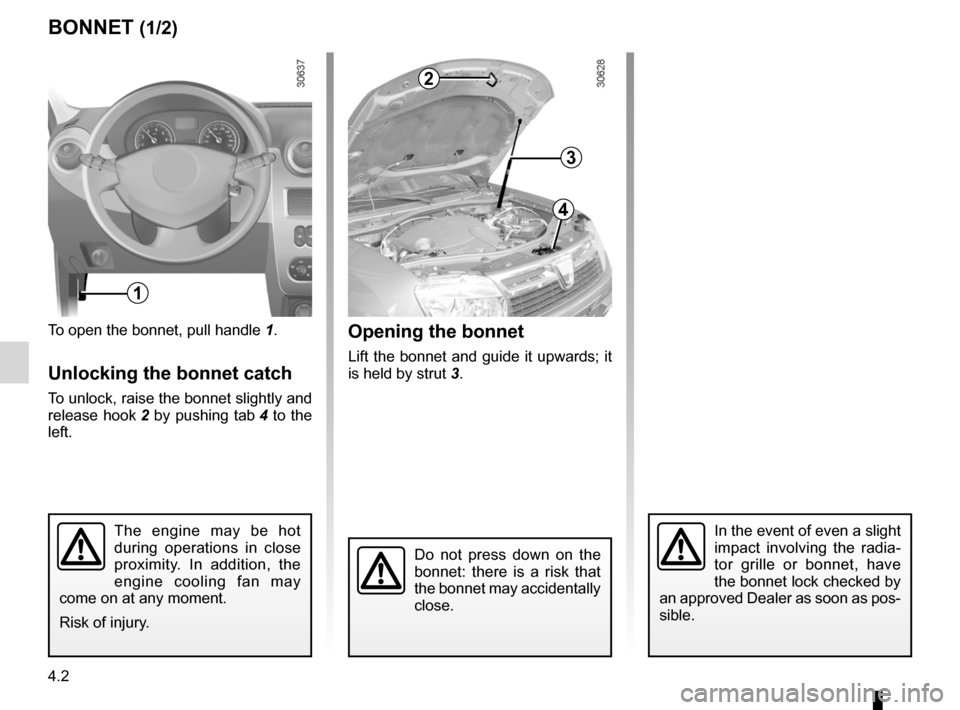
bonnet................................................... (up to the end of the DU)
4.2
ENG_UD22440_4
Capot moteur (H79 - Dacia)
ENG_NU_898-5_H79_Dacia_4
Jaune NoirNoir texte
Bonnet
BONNET (1/2)
To open the bonnet, pull handle 1.
Unlocking the bonnet catch
To unlock, raise the bonnet slightly and
release hook 2 by pushing tab 4 to the
left.
Opening the bonnet
Lift the bonnet and guide it upwards; it
is held by strut 3.
The engine may be hot
during operations in close
proximity. In addition, the
engine cooling fan may
come on at any moment.
Risk of injury.In the event of even a slight
impact involving the radia -
tor grille or bonnet, have
the bonnet lock checked by
an approved Dealer as soon as pos-
sible.
Do not press down on the
bonnet: there is a risk that
the bonnet may accidentally
close.
2
3
4
1
Page 121 of 200
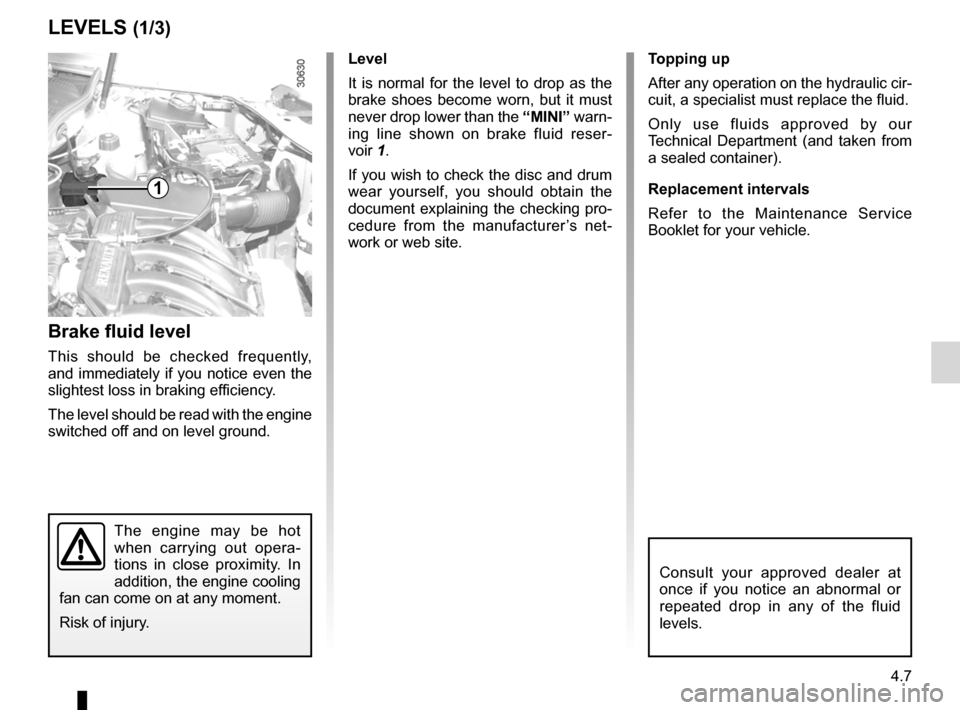
levels .................................................... (up to the end of the DU)
brake fluid .............................................................. (current page)
maintenance: mechanical ....................................................... (current page)
tanks and reservoirs brake fluid ........................................................ (current page)
4.7
ENG_UD20646_2
Niveaux (H79 - Dacia)
ENG_NU_898-5_H79_Dacia_4
Levels:
Brake fluid
LEVELS (1/3)
Brake fluid level
This should be checked frequently,
and immediately if you notice even the
slightest loss in braking efficiency.
The level should be read with the engine
switched off and on level ground. Level
It is normal for the level to drop as the
brake shoes become worn, but it must
never drop lower than the
“MINI” warn-
ing line shown on brake fluid reser -
voir 1.
If you wish to check the disc and drum
wear yourself, you should obtain the
document explaining the checking pro-
cedure from the manufacturer ’s net -
work or web site. Topping up
After any operation on the hydraulic cir-
cuit, a specialist must replace the fluid.
Only use fluids approved by our
Technical Department (and taken from
a sealed container).
Replacement intervals
Refer to the Maintenance Service
Booklet for your vehicle.
The engine may be hot
when carrying out opera
-
tions in close proximity. In
addition, the engine cooling
fan can come on at any moment.
Risk of injury.
Consult your approved dealer at
once if you notice an abnormal or
repeated drop in any of the fluid
levels.
1
Page 128 of 200
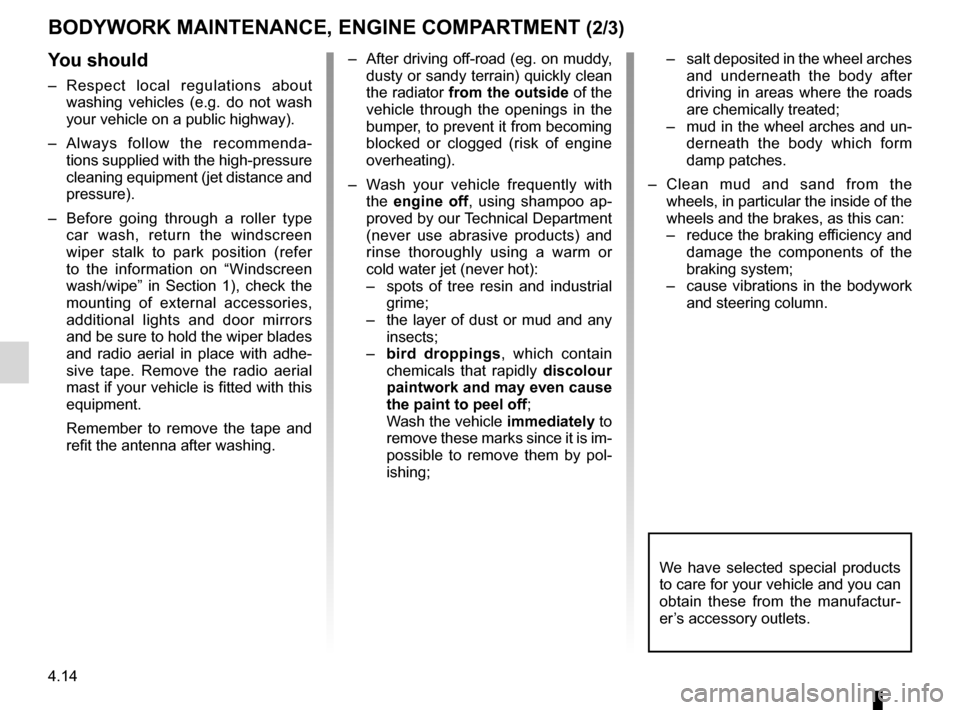
4.14
ENG_UD20966_2
Entretien de la carrosserie / compartiment moteur (H79 - Dacia)
ENG_NU_898-5_H79_Dacia_4
Jaune NoirNoir texte
BODyWORK MAINTENANCE, ENGINE COMPARTMENT (2/3)
y ou should
–
Respect local regulations about
washing vehicles (e.g. do not wash
your vehicle on a public highway).
– Always follow the recommenda -
tions supplied with the high-pressure
cleaning equipment (jet distance and
pressure).
– Before going through a roller type
car wash, return the windscreen
wiper stalk to park position (refer
to the information on “Windscreen
wash/wipe” in Section 1), check the
mounting of external accessories,
additional lights and door mirrors
and be sure to hold the wiper blades
and radio aerial in place with adhe -
sive tape. Remove the radio aerial
mast if your vehicle is fitted with this
equipment.
Remember to remove the tape and
refit the antenna after washing. –
After driving off-road (eg. on muddy,
dusty or sandy terrain) quickly clean
the radiator from the outside of the
vehicle through the openings in the
bumper, to prevent it from becoming
blocked or clogged (risk of engine
overheating).
– Wash your vehicle frequently with
the engine off , using shampoo ap -
proved by our Technical Department
(never use abrasive products) and
rinse thoroughly using a warm or
cold water jet (never hot):
– spots of tree resin and industrial
grime;
– the layer of dust or mud and any
insects;
– bird droppings , which contain
chemicals that rapidly discolour
paintwork and may even cause
the paint to peel off ;
Wash the vehicle immediately to
remove these marks since it is im-
possible to remove them by pol -
ishing; –
salt deposited in the wheel arches
and underneath the body after
driving in areas where the roads
are chemically treated;
– mud in the wheel arches and un-
derneath the body which form
damp patches.
– Clean mud and sand from the
wheels, in particular the inside of the
wheels and the brakes, as this can:
– reduce the braking efficiency and
damage the components of the
braking system;
– cause vibrations in the bodywork
and steering column.
We have selected special products
to care for your vehicle and you can
obtain these from the manufactur -
er’s accessory outlets.